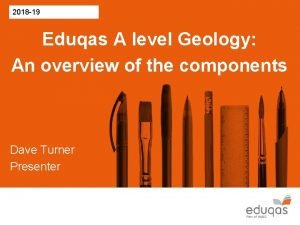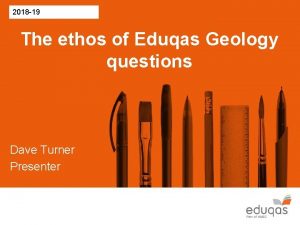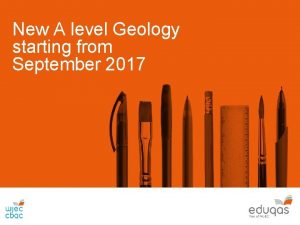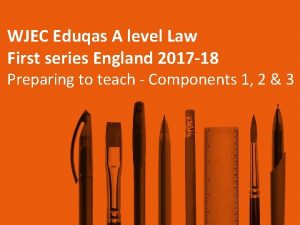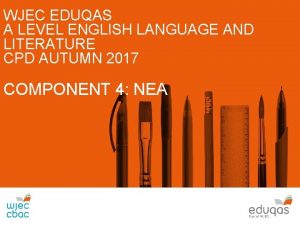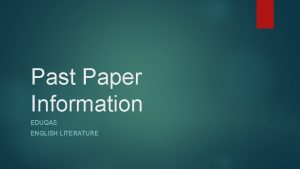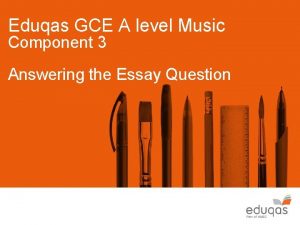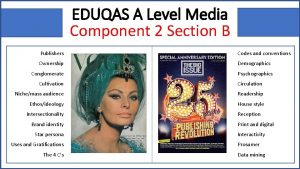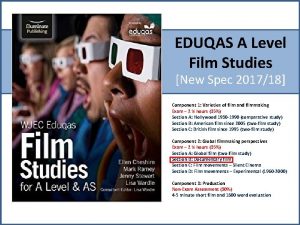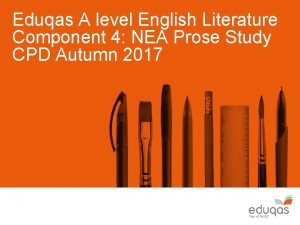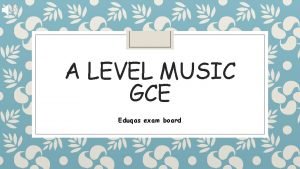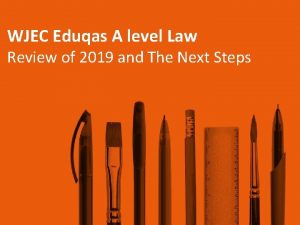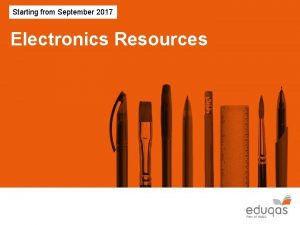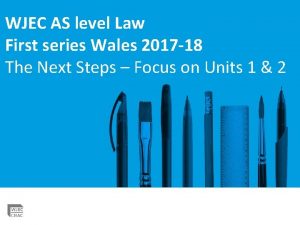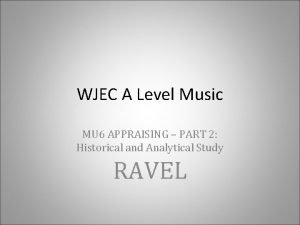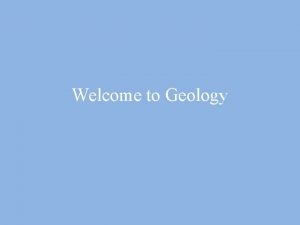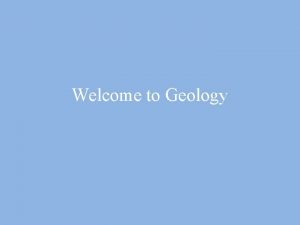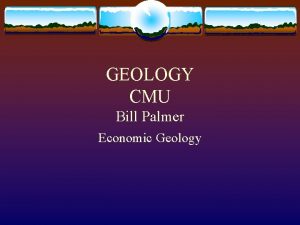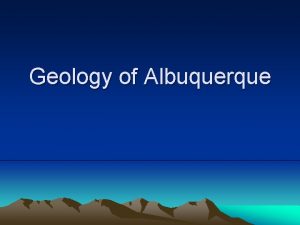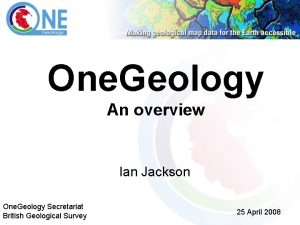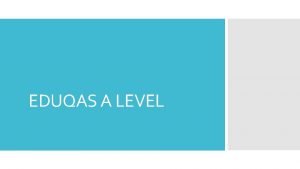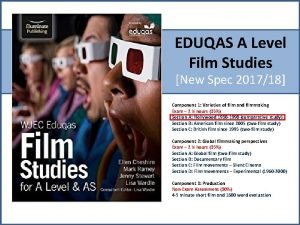2018 19 Eduqas A level Geology An overview























- Slides: 23

2018 -19 Eduqas A level Geology: An overview of the components Dave Turner Presenter

Audio Recording The presenter is required to make an audio recording of this event. This is a control designed to ensure that WJEC is able to demonstrate compliance with regulatory Conditions of Recognition; specifically Conditions relating to the confidentiality of assessment materials. The recording will be made available to the qualifications regulator if required, but it will not be shared with any other third parties. The recording will be stored securely by WJEC for a period of three years and then permanently destroyed. Please note that delegates are NOT PERMITTED to make an audio or video recording of any aspect of this event.

A Level Component 1: Geological Investigations Written examination: 2 hours 15 minutes 35% of qualification Component 1 could cover any content from the first two sections of the specification • F Fundamentals of Geology and • G Interpreting the Geological Record Section A: Two stimulus response questions requiring short and structured answers. Questions will range from 1 - 4 marks They will resemble old spec WJEC GL 4 section A questions

A Level Component 1: Geological Investigations Section B: Investigation of the geology of an area shown on an accompanying simplified geological map, involving: • interpretation of hand specimens and • Interpretation of photographs of minerals, rocks and fossils • map interpretation • cross-section construction Involves completion of questions using short, structured and extended answers. • Typically 3 or 4 specimens so no change there from GL 2 a and the Eduqas AS component 1. Usual mix of rocks mineral and fossils. • There will be a resource sheet with the A 3 black and white map and typically 2 -4 photographs on the back • There will be a mineral data sheet. The same one for AS and A level

A Level Component 1 Big change compared to GL 2 a is that teaching staff are not permitted in the exam room at the start of or during the examination (same for the Eduqas AS examination this summer) To overcome this centres will have access to 3 documents. 1. "Instructions for candidates" sent to EOs e mail 2. "Instructions for exams officers" sent to EOs e mail 3. "Instructions for technicians and invigilators" on the secure website

A Level Component 1 The key features of the changes are: Teachers are to share with the candidates in advance of the exam (i. e. in lesson time) the instructions that might have been given by a teacher in the exam room. e. g. • • • Geological equipment that they can use in the exam Use of a resource sheet and mineral data sheet Need for ruler, eraser, protractor and calculator The fact that the specimens are one set between two and how to manage that (e. g. candidates cannot walk round the room, nor communicate with other candidates, nor attempt the questions in order necessarily) There are photographs which accompany the specimens indicating the "letter" of each specimen

A Level Component 1 There are instructions sent to the exams officer which outline the procedure for: Teachers checking the specimens well in advance of the exam (in the exams office only), The equipment required for candidates The fact that a teacher is not permitted in the exam room but a competent technician must be (in addition to invigilators) The layout of the exam room: double desks, specimens to be close to each pair of candidates Collection of specimens after the exam Return of specimens

A Level Component 1 • Needs to be a technician in the exam room for the whole duration of the exam, in addition to invigilators • The technician must not have played any role in the preparation of candidates for the exam • Role of the technician is only to handle issues related to functioning of the geological equipment e. g. an acid dropper bottle not working properly, a "cloudy" hand lens • Invigilators and/or the technician should check that candidates have not forgotten to return the specimens that they have finished using • In extenuating circumstances, the technician may need to facilitate a candidate being able to view an alternative specimen

A Level Component 1 How will the A level “practical” be different from AS Component 1 and GL 2 a? 1. Questions will develop into A level standard i. e. go beyond those of the AS spec only. e. g. having identified the white mineral in a diagram, the question could develop by assessing knowledge related to Bowen's reaction series. 2. There will be two Extended Response Questions, one of 6 marks and one of 9 marks, marked using a banded mark approach. These will both be in Section B, the "practical exam" section as can be seen in the SAMS. 3. The map will be of A level standard and therefore will be a step up from the AS/GL 2 a maps since they may contain:

A Level Component 1 Plunging folds A transgressive intrusion

A Level Component 1 More advanced igneous bodies e. g. this has a series of cone sheets. Students will be able to deduce these by the dip data on the map. No need to teach "cone sheets"

A Level Component 1 More complex "hidden geology" on the line of section, in this case beneath a thrust fault Overturned bedding using a symbol

A Level Component 1 • Overturned bedding not using a symbol (because the limbs in the central fold both dip towards the north). • Note plunging folds and the transgressive intrusion These and the cross profiles can be found on the A level Geology webpage The solutions to the cross-sections are on the secure website

A Level Component 2: Geological Principles and Processes Written examination: 1 hour 45 minutes 30% of qualification Component 2 could cover any content from the first two sections of the specification • F Fundamentals of Geology and • G Interpreting the Geological Record Six stimulus response questions requiring short, structured and extended answers Will typically have 2 × 6 mark extended response questions Resembles most closely 6 questions in the style of old spec WJEC GL 4 section A questions

A Level Component 3: Geological Applications Written examination: 2 hours 35% of qualification Section A: Geohazards 30 marks 35 minutes recommended • Section A assesses theme T 1 Geohazards • Assumes an understanding of the first two sections of the specification, Fundamentals of Geology and Interpreting the Geological Record. Two stimulus response questions requiring short and structured answers from 1 -4 marks. (No QER here) They will resemble old spec WJEC GL 3 section A questions but be of A level standard rather than AS (which GL 3 Hazards was)

A Level Component 3 Section B: Geological map applications 45 marks 50 minutes recommended • Section B assesses theme T 2 Geological map applications • Also assumes an understanding of the first two sections of the specification, Fundamentals of Geology and Interpreting the Geological Record, and theme T 1 Geohazards. An investigation of the geology of an area shown on a Geological Survey map extract using stimulus response questions requiring short, structured and extended answers. (No QER here) Questions will be most similar to questions in the old spec WJEC GL 4 section B

Geological survey map extract- A level SAMS

A Level Component 3 Section B: Geological map applications Good use should be made of the GL 4 maps and mapwork questions dating back to 2002, on the website

A Level Component 3 Section B: Geological map applications The answers to all the past GL 4 map questions are on the secure website

A Level Component 3 Section B: Geological map applications The Eduqas specification demands greater assessment of mathematical skills than former WJEC and OCR specifications The BGS maps offer the opportunity for the teaching and assessment of a number of the mathematical skills Teachers may wish to develop some of these using past GL 4 maps This is developed in the presentation “Using past WJEC GL 4 maps”

A Level Component 3 Section C: Option Themes 30 marks 35 minutes recommended The only place where there is choice (but not for candidates) Learners answer questions on one option from a choice of three. T 3 Quaternary Geology T 4 Geological evolution of Britain T 5 Geology of the Lithosphere • Section C assess the chosen option theme • Assumes an understanding of the first two sections of the specification, Fundamentals of Geology and Interpreting the Geological Record.

A Level Component 3 Section C: Option Themes Each theme consists of 2 data response questions with answers of typically 1 -3 marks, and one "stand alone" QER question This section most resembles old spec WJEC GL 5 section A questions

A Level Component 3 Section C: Option Themes There is no choice of questions for candidates within their specified topic that they have studied Important to flag up to candidates that they are better served by answering the questions on the topic they have studied!! They should not attempt to answer all 3 options even though all 3 options will be in the same question paper (unlike old GL 5 themes in separate booklets)
 Eduqas geology a level
Eduqas geology a level Eduqas geology
Eduqas geology Wjec a level geology
Wjec a level geology Eduqas a level law past papers
Eduqas a level law past papers English literature a level wjec
English literature a level wjec Eduqas a level english language
Eduqas a level english language Midwinter grahame davies
Midwinter grahame davies A level music eduqas
A level music eduqas A level media vogue analysis
A level media vogue analysis Film studies a level eduqas
Film studies a level eduqas Eduqas english lit a level
Eduqas english lit a level Eduqas english literature a level
Eduqas english literature a level Eduqas religious studies a level past papers
Eduqas religious studies a level past papers Criminology unit 4 ac1.2
Criminology unit 4 ac1.2 Wjec a level english language and literature
Wjec a level english language and literature Eduqas electronics a level
Eduqas electronics a level Eduqas a level music
Eduqas a level music Eduqas law a level
Eduqas law a level Eduqas product design a level
Eduqas product design a level Wjec a level electronics
Wjec a level electronics Eduqas law
Eduqas law A level law wjec
A level law wjec Wjec music a level
Wjec music a level Eduqas english literature a level
Eduqas english literature a level
